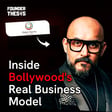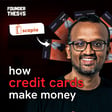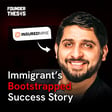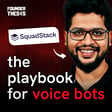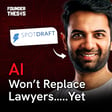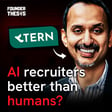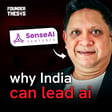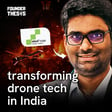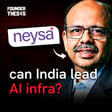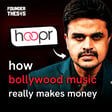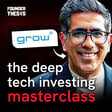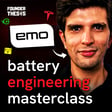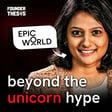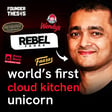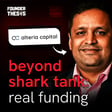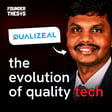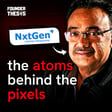Become a Creator today!Start creating today - Share your story with the world!
Start for free
00:00:00
00:00:01

Arvind Parthiban (SuperOps) on The Power of Product Marketing
In this episode, we dive into the entrepreneurial journey of Arvind Parthiban, CEO & Co-Founder of SuperOps, a $50M SaaS company. Arvind highlights the critical role of product marketing in startup success and emphasizes the importance of purpose-driven entrepreneurship.
Akshay Datt, a serial entrepreneur who has run ventures in employability training and hiring, hosts the Founder Thesis podcast. He has interviewed 500+ founders to date.
Connect:
Arvind Parthiban: https://www.linkedin.com/in/arvind-parthiban/
Akshay Datt: https://www.linkedin.com/in/akshay-datt/
Founder Thesis: www.founderthesis.com
Transcript
Startup Community Dynamics
00:00:00
Speaker
But in early days, it's the community helping with each other. So that's why it's similar to SaaS Bumi. Early days, you might need more help from other founders like other MSPs. And later you become big and you ah help it. So community is exactly like a startup community in the MSB market as well.
00:00:15
Speaker
In a community, don't sell. if you The moment you start selling, people will be like, I don't want to be part of it. You know, sometimes people become entrepreneurs because they see a pain and they want to solve it. Either time someone wants to be an entrepreneur, then he goes out and looks for pain areas. I think it was the second case with you, right?
Arvind's Career Journey
00:00:30
Speaker
And the first criteria in my mind was, hey, I need to build a product which doesn't compete with your old fresh books. I ran a recruitment agency for about 10 years and I learned a lot about the kind of people who are doing different kinds of work in startups. One of the interesting roles I learned about was a product manager who is essentially responsible for ensuring a cash product that consumers love.
00:00:53
Speaker
Another interesting term or role in the startup world is of a product marketeer. And in this episode, I am speaking to Arvind, the founder of SuperOps, who really is an excellent product marketeer. And he helped me learn a lot about the different ways in which product marketing happens.
00:01:12
Speaker
Arvind has done product marketing for a whole host of companies and businesses, starting with Zoho and then Freshworks and now SuperOps. And the fact that SuperOps has raised more than $50 million dollars so far with the last round of $25 million dollars just happening a couple of weeks back is proof of his success as a product marketeer. You're listening to the Foundathesis podcast and I'm your host Akshay Dutta.
00:01:42
Speaker
Arvind, welcome to the Foundry Thesis podcast.
Transitioning Roles and Learning Product Marketing
00:01:45
Speaker
Looking back, can you connect the dots on how you became an entrepreneur in the first place? Okay, this might sound funny. First of all, thank you for having me in this podcast. ah The first interview I ever had in Zoho back then, it was called Advent, when Girish hired me as a fresher out of a college. He asked me, what is it you want to do? I said, I wanted to be an entrepreneur.
00:02:08
Speaker
This is something which which has been my dream because I actually took my dad's dream of being a successful entrepreneur. He's always tried and he's been an entrepreneur. I've seen him try. We didn't have that exposure back then. ah So for me, taking up the dream was one half of the reason and the other half of the reason is after I joined Zoho, it became much stronger to start a company myself. So Girish hired you in Zoho, like he was still in Zoho at that time.
00:02:36
Speaker
Yeah, yeah. he This was back in 2005-06. So when I joined, it was Adranet. And after that, I worked with him for six years over there in Zoho under him. OK. Amazing. Amazing. So how did you end up discovering marketing as your passion?
00:02:53
Speaker
Okay, that's a very funny story. So, I joined as a pre-sales engineer. This is like, I'm a techy computer engineer who was forced to do computer engineering like every a kid in the family, right? Like go do your engineering and then decide what you want to do. So, I did computer engineering and realized I'm really bad at coding. So, when I interviewed, I said that hey I don't like coding, but I can understand technology but where I can actually There are a lot of non-coding tech job in India. Like at the time we didn't know that. I said I understand technology. So basically in the interview they asked me to explain about routers and things like that and I got the job, I'm assuming that I asked that. So they created they gave me a role called pre-sales engineer. So pre-sales engineer job is where first half of the job is to go and give a demo and basically sell the product technically. It's a technical brochure.
00:03:41
Speaker
The second part of the job is where you implement the product. ah you You have to go to the customer's environment, implement and train all the people who are using the product. We are selling a product called IT Service Management, Service Task Plus, where we are selling it to techies who have to use this product too soon. So my first job from 2006 to 2008, 2009,
00:04:04
Speaker
is to go around the globe, travel everywhere, implement the product, train the folks. I did more than 150 implementations. And then I actually got tired of
Understanding Product Marketing
00:04:13
Speaker
traveling. ah It's like in the Up in the Air movie where I was say in holiday in hotels and eating pretzels in Southwest Airlines. I really got tired and I basically said like, click the life is about having Dal Chawal at home. It's much better. is That's when I went and told Girish saying that then I can't do pre-sales anymore like tell me if there is anything else you want. So he asked me what is that you want to do and I said I want to do marketing. And there was a role called product marketing in 2008. Said this is what product marketing is. He gave a laptop and said go figure it out. Go see these two websites. It was Atlassian's website back then. And it was FreshBooks. These are the two websites. He said go check these two websites and figure out what product marketing is.
00:05:00
Speaker
I tried to call all my friends to ask, okay, what is product marketing? Most of my non-tech people thought marketing means taking a bag and going door to door and doing telemarketing is what they did. They didn't know what product marketing is and that there is function of product marketing, nobody knew at the time. So we did all the mistakes in life to understand product marketing. We did airport ads, which is like the stupidest thing I did in my career.
00:05:27
Speaker
to do as a product. like We did try and learn that. We didn't have the DNA and at the time. We had to make mistakes. like We'll try 10 things. Eight will not work. Two will work. We'll document it and double down on it. That's how we learned product marketing. Until now, I don't have an MBA in mban marketing, but I am a very proud marketer. Amazing. What is product marketing? How is it different from a regular marketing function or how is it different from product management?
00:05:52
Speaker
See, ah there are different kinds of product marketing today. If you ask me, there are 15 different kinds of marketing. okay If you want me to break it down into three different buckets, I will call it growth marketing, product marketing, and brand marketing, high level buckets for a startup. Say let's take a company with less than 20 million revenue, you can but divide it into three market buckets. Growth marketing's job is to generate leads for you at any cost.
00:06:19
Speaker
that that is the job of a growth marketing, whether the you do inbound, outbound or markups, whatever it is, right like SDR, all this comes under growth marketing. Brand marketing is to be make sure the brand is heard, social, PR and those kind of things, you basically top of the funnel job is brand marketing. But product marketing is a very tricky thing, like like there is a different definition in different companies, in the ah but this is what my definition I use in super, like a product marketing the first most important job of a product marketing is, is to position and message your product right. Like, who are you going after? Who is the ICP? Can I actually ah message and position on what messaging I want to, the emotion of the particular brand has to be given to them. So, positioning, messaging, website, all this comes under one aspect of product marketing. The second aspect is basically sales enablement, where
00:07:16
Speaker
There is a visitor to sign up conversion, sign up to customer conversion. When it comes to visitor to sign up conversion, that is one part of it, how website is done, that is also product marketing. Sign up to customer conversion, half of sales enablement comes there, like what kind of mailer has to go, what kind of drip marketing has to go, like how are we going to give the sales enablement comparing the competitors and things like that. That is a very important part of product marketing.
00:07:39
Speaker
And the ah ah third bucket is pricing, cab, learning and training sales and customers. For instance, the product marketing will be the bridge between product management and the GTM teams or even the other functions like partners and things like that.
00:07:57
Speaker
So, sometimes a lot of companies product management themselves they do this job, technically product marketing has to do, they have to do the wind loss analysis, they have to be the bridge and taking the information from all the GTI marks to the product and taking the feature and the product from the product team training the GTM org and vendors and partners and everything, this is also a job of product marketing.
Marketing Strategies and Team Dynamics
00:08:22
Speaker
So basically, taking a feature and product to the market is their responsibility. In high high level answer, this is what it is. I can go into the nuances of nitty-gritty as well, but this is what product marketing is.
00:08:33
Speaker
In your three buckets of marketing, where does the GTM team fall? so you had growth brand so In i say ah g GTM, my ah see this is marketing. These three are marketing. I'm including sales, partners, pre-sales, customer success, all this as under GTM also. That is sales, basically. Got it.
00:08:55
Speaker
In ah growth marketing, you said markups, what does markups mean? I am not familiar with that. So, markups is basically all the analytics and data which is required from the marketing team, the markups team will do. So, basically what is the website business, how much conversion rates, like what is the cost per lead, like they will bring all this analytics of marketing analytics that that team is called Markups. They'll also, if you have to take a list of ah some companies you need to target, so they will use the tools and give you data for marketing to go and do their camera campaigns right, so that team is called Markups. Okay, okay, okay, understood, okay, okay, understood. I guess, you know, there would be stages when you would need
00:09:44
Speaker
this kind of a marketing organization, ah at what stage does a company start to need a product marketing function as a standalone, well-defined function? I've told this in multiple podcasts and don't take it because I am a marketing CEO. I always think that your founding team should have a marketer and the first marketer should actually be a product marketer.
00:10:13
Speaker
The reason is see the importance of ICP analysis and how we are going to target. The ICP is very, very important. right like Who are we selling? In those days, when you are selling to, if you are selling a CRM, it's very simple. I am going to sell to all salespeople.
00:10:30
Speaker
But if you are selling a product where if your persona has to be defined, who are we selling? How are we going to target them? Is there a market for that? What features has to be built? Getting on calls, discovering the features. All this is a marketer's job. And I want to emphasize very strongly that in India, product manager and does this half of the job. And that is not their expertise. And marketing, who has to go and generate the leads?
00:10:57
Speaker
as the second half of the job. like i made it's like Think about it like ah I run a restaurant. I made biryani. Who is going to eat the biryani? Which location I have to have the biryani? And how am I going to sell? How am I going to price? It's the job of a marketer. This is a question we need to ask before you start a company. Not after I made the biryani. Now you ask the guy, say, hey, I have a shop. I have made the biryani. You go and sell it now. That's not how business works. right You need to ask these questions before they say to set a shop.
Entrepreneurial Ventures and Lessons
00:11:27
Speaker
Let me kind of get back to the journey. So you started with Zoho. How did this eventually transform into entrepreneurship? Okay, so I after I became a marketer till 2014 and I was heading the ITSM marketing over there. In 2014, I did a campaign. So it was a campaign when first service was about to be launched.
00:11:58
Speaker
So I did a campaign where we had to ah We had to actually launch a campaign and make a product free to disrupt that market and make helpdesk a commodity So we launched a product called service test plus a comp complete edition completely free so I did a campaign in London saying that there is no such thing as free lunch and I made one of the influence Actually, one of the influencers wrote saying that there is no such thing as freelance. So we brought a food truck for the event. There was like 4,000 people in the event, like food truck, like we have fish and chips and sliders. We gave away like 2,000 food for all the attendees in the event. And we basically said, do you agree now there is such thing as freelance? And the product is for free. We generated almost 80,000 leads in that one single campaign.
00:12:50
Speaker
So after that campaign... It was like a video campaign, like you were shooting all this, like people eating and then you produced it into a video. We got covered in TechCrunch, we got covered in Gartner and everything. The campaign became a really big hit. So i that kind of kind of actually was disrupting the market. At the time, I actually got an offer from...
00:13:10
Speaker
getish He basically said, I want you to come and head marketing in Freshworks. Why didn't you? My then Girish had left Zoho and started. He started 2010 and ten and the company was in a good place and he launched a second product. and So I was supposed to join with him at the very early stage, but because I was not part of the founding team, of a team I ah kind of like wanted to be a founder or probably join on a stage where I head the marketing like that. So, that is how I was thinking. But when he approached at the time, I told him that ah I might not want to join now, I would rather want to start in future. So, he asked me a question like, what do you mean in future? Like, why don't why not now? I said, I do not know, I do not know if I am ready now. So, this is happening in the Goa project where we were in
00:14:01
Speaker
ah goa We went went to an event together. So he said, you are ready. If you want to start, I will invest. I will back you. I have confidence in you. You can go and start. So that ah push actually gave me the confidence. I said, okay, let me think and start as how I decided and I started ah in 2015. So that's how Zargit happened.
00:14:24
Speaker
so what did you How did you identify what you want to build? you know you You knew you want to do entrepreneurship, but it wasn't like... You know, sometimes people become entrepreneurs because they see a pain and they want to solve it. ah And at the time someone wants to be an entrepreneur, then he goes out and looks for pain areas. I think it was the second case with you, right? Yeah. So I think this is something which I would say as my first mistake. ah And this is what I would want to also all all all other other founders to also think about it as. See, the way I thought at that time was A, there were like close to around 70 to
00:15:03
Speaker
100 products at the time Zoho was building and Freshworks had like around three products at the time. And the first criteria in my mind was, hey, I need to build a product which doesn't compete with Zoho or Freshworks. The second thing is, okay, what does what are the things I know? Well, one is I have been an ITSM person all my life. I have been in IT, ITSM and I've been a marketer. So I thought, okay, let me pick a product which is in the marketing domain. So, which is something which I know second best. And then I picked the product in the marketing and ideally I wanted to build a marketing automation platform, but the first step was to build a conversion rate optimization software, A B testing and heat map and things like that. so So, that is something which I knew as a marketer well. So, I picked. Even though I am a marketer. Webengage has something. Not Webengage, it is basically viify
00:15:59
Speaker
OK, Vingify. Vingify is a market and optimist. The model I know well is SMB, SMB GTM motion. And I picked a product which i which is a marketing space. We actually had in two years, if you use the Zagit journey, we raised from Sequoia, Axl, and Matrix. We had a very good team. for All the Freshbox founders ah have invested.
00:16:27
Speaker
we in like launch launch 7.5 million. At that time, 7.5 million is actually a big two round seed and series. India at that time is massive. It's equivalent to a 20-30 million round today. yeah Exactly. And the kind of board I had was Axle, Sequoia, like they were ah the leaders in the space and then Matrix.
00:16:50
Speaker
So, I had a so very big board even at a series a stage. Like imagine where I am a new founder. In the board there is Girish, Shekhar Kirani, Anand Daniel, Tarun Davda, and then Sailesh Lakhani. It was a board where everybody had stronger opinions. So, I am a first ever founder. It was so funny. So, I launched the product in six months. I had 300 customers.
00:17:17
Speaker
we quickly came to half a million revenue. It was fast, but then after six months I saw almost 150 customers are not using the product and they're churning. And I'm like, what happened? like ah So I spoke to most of the customers and asked like, why are you not using it? They said, first we change the website. The website is working well now. We don't need the software anymore. So then I asked like, will you not change the website
Post-Acquisition and Marketing Innovations
00:17:41
Speaker
again? and Maybe in a year or two, but not now. So what I learned there is like a small businesses, they don't change the website often. They change once in two years.
00:17:51
Speaker
but Very large businesses, are the web server businesses we our ads landing pages every week or every month. It's a use and throw software. People love the product, but they are like, oh, I don't need it anymore. So that was the point where I decided, OK, I had no choice other than going upmarket, where I have to change my complete GTM motion to sales from consultative selling from low-touch sales. So I have to change my GTM motion.
00:18:17
Speaker
move up market and in that up market there are players like Adobe target, Montate, Optimizely, Google and they are mammoths of the company who have invested in like ah golf course selling and sales people coming in Ferrari and selling right like that was the moment I was like a stumped I was like okay what to do now should I pivot because my product is good I have to figure out GTM motion.
00:18:41
Speaker
And my co-founders are also like emotionally attached to the product. like Should we pivot? No. like Can we figure out GTM? So that is the moment we decided, OK, listen, let's take a small win. And we got a acquisition offer from Freshworks. The acquisition offer was actually, in hindsight, one of the best decisions. During the IPO, the value of Zargat acquisition was $280 million. dollars Everybody made money. like and what What does that mean? Like the stocks given to Zargate investors were $250 million. So it was a stock swap. When Threshworks was a $700 million company, we got acquired as a stock swap. And the stocks multiples during the IPO was $280 million. So wow it was a very good exit. Phenomenal. OK. OK. So then what next? What what did you do at Thresh?
00:19:35
Speaker
Yeah, so I got acquired and I ah usual my old boss Girish, he knows my strength, he put me in marketing. I was heading product marketing and cop marketing at Freshworks. There are like almost five products at the time. ah So there I did I'll say two or three things which I did. I was there for a brief time, only two years. My agenda was to learn from him again, like to see how the VC game is. I've worked with him in Zoho, but I wanted to work closely with him. So, cop marketing was one of the things which I was doing very closely with him.
00:20:08
Speaker
Two things which I did the at Freshworks is we rebranded fresh this to Freshworks where I did a campaign against Salesforce where we wanted everybody to know what Freshworks is. So we flew a blimp on top of Salesforce star and we coined a term called Salesforce. It was a developer conference I think.
00:20:28
Speaker
ah
00:20:32
Speaker
Salesforce's biggest conference is called Dreamforce. 200,000 people two hundred thousand people at attend the conference in San Francisco, pretty much the whole city is only the Salesforce attendees. We wanted to brand fresh work from fresh desk to fresh works. So we took billboard ads, bus ads and like a lot of areas we had some ads, but the cherry on top, we wanted media to cover it.
00:20:53
Speaker
So that is how this ah fails force happened and surprisingly it went so big at the same time. what did the jump fails force And again, we didn't coin that term. It was a term coined in Reddit, everybody who are unhappy with Salesforce, they were using the hashtag called Salesforce. So we took that Salesforce and we put it and we basically said, there's a better alternative called Salesforce. And that was my campaign. And Mark Benioff himself tweeted saying that this is a great campaign, you should give him a raise.
00:21:27
Speaker
Till date, Freshworks, any coverage happens about Freshworks. It's been what, 2018 to now, almost like seven years, they carry the blimp picture. Till now. Yeah, I have also seen that blimp.
00:21:44
Speaker
Yeah. So the second thing which I did is I created a community for Freshworks called refresh. So we but basically did a user conference and a community for Freshworks. So that is one thing which is a big activity. Otherwise, the usual stuff like product marketing, we had the Legion numbers and things like that.
00:22:02
Speaker
I was there for two years and I got this tattoo just to remind me to start a company as soon as my golden cuffs are done. la For me, ah see I'll tell you why it is important I wanted to start a company and this is what I usually tell my employees who are here who joins.
Purpose and Personal Drive in Entrepreneurship
00:22:21
Speaker
And that I also think is my purpose of why I'm doing because I did have a good exit and it's not about the money. I'm not saying money is not important, money is definitely important. But you also need a purpose ah because in tough times the purpose is what will define what you want to do, right? Money will push you so much, but a purpose will push you much harder. I come from a very poor family.
00:22:44
Speaker
my ah dad is a farmer's son, first graduate out of his village and he did not have enough this one exposure even to study and go study more than what he did. In that district that is the library had so much only. So, he did this BA and then he could not do after that. He went and joined a company called the Almet Industries by in Osora, Osora is an industrial town there.
00:23:14
Speaker
There he joined the company mix bulbs tungsten wire. So, it produces X amount of wires per minute. He joined in that company in a month. He actually reassembled like that's a huge machine. Like he reassembled a German machine and he actually made 6X more output by reassembling the machine. And then he himself started a company in couple of months and he employed 150 people from our village and everybody.
00:23:45
Speaker
and It did go well. And then after two years, because he doesn't know the entire nuances of business, it's not just the product. rate It's procurement, supply, demand, everything, right finances and everything. He didn't have that experience there and he failed. right and that After that, to come back and start, he tried a lot of other businesses, but ah ah it didn't go out well for him at the time. But whenever I go to my festivals in my village, ah all the folks who worked for my dad, they will come and sit there and say that if my life changed because of your dad.
00:24:22
Speaker
We learnt there, I moved to Jamshedpur, I am working in this company because of the technical know-how. The lifestyle of the entire village went up and everybody will come and thank my dad and they will tell me and I kind of felt that I was very proud but I was also wanting my dad to be also be a successful entrepreneur.
00:24:41
Speaker
But I'll also give you a same example which struck very hard in my mind is, in 2008 when I wanted to be a product marketer, when I wanted to learn from somebody, there was nobody in my friend circle in whole of India who knows product marketing, to go and ask hey what is product marketing?
00:24:57
Speaker
But today, and two to twenty twenty five in in Chennai, if I want product marketer, there are expert specializations, 15 different marketers I can hire. What happened from 2008 to 2025 is there are companies like Zoho, Freshworks, ChargeB, people been there, done that, the technical know-how has been passed on. Now, today, if I want to hire a marketer in Chennai, it's easy.
00:25:22
Speaker
but Like this is what a great company does, right? Like Zoho has employees, Freshworks has 6,000 employees. People who have been through the journey and I am confident to run SARS companies because I was i was in Zoho and Freshworks, I know the game. This is what is stuck very hard for me. I think ah the technical know-how of ah building companies. So I got the start to fulfill my that stream to be honest. I want to create a company which can at least employ 5000 people and teach the technical know-how which will build the future for the next community. right Like this is what my dream is. In the process I will definitely want to make my money, I want to drive a fancy car, that and all is there. I am not saying
00:26:06
Speaker
It's all only this, but definitely there. But in a tough time, this is what will push. And so the reason why I wanted to start against Supraps, even though we got a good exit from Zargit, is I need to complete the time because even Zargit, it was just two years and I didn't see the game completely. So I want to see it truthfully. And that's how Supraps happened. So, you know, as a repeat founder, you are armed with the some thesis that these were things which I will not repeat as a mistake again this time around what was that?
Strategic Insights and Market Adaptation
00:26:41
Speaker
Okay, so I told you the first mistake right like where I built a ah ah good to have product like are you selling a vitamin or are you selling a painkiller? So my Zargat experience was I was selling a vitamin.
00:26:56
Speaker
It's not a mission critical product, it was a use and throw software. So I decided that I will only build a mission critical product which every day somebody has to use. It's like without using it, I can't do the job. And the second thing which I learned from Zargett is A, this is a Rajni dialogue. right ah Basically in one movie Rajni says that A,
00:27:20
Speaker
a person, who like it's about knowing things. like If you know something really well, do that. That is the most important thing. I have been an ITSM guy all my life for 10 years and like now almost 20 years. i that is what That was my life. it's like I'm not using my strength.
00:27:40
Speaker
like why did I go and pick a product market which I don't know, rather I want to go back to the IT market. So, that is how super ops I decided I will be in the IT and MSP market. like Something which I know very well like how many people in India can say that I have 20 years of experience in the space, very few people like I can account for 4 or 5 people and that is something which I threw away, I do not want to do that. So, that is why I came back to IT. The third most important thing which I learnt is See, sometimes startup is like poker. You should know when to fold, when to raise, when to, right? A lot of times for as a founder, we confuse being persistent resilience, I don't quit attitude. Okay, that is important. But don't confuse on getting to know the answers. There are multiple ways to go to, let's say you're climbing a mountain. You need to go and reach that mountain stop. There are different paths in which you can go.
00:28:37
Speaker
You figure out your path. you need you Going and reaching the top of the mountain is your goal. Do not quit till you go reach the mountain. That is resilience in a person. But if you are going in the wrong direction, you should have that mindset to course correct the path. You are going in opposite direction. Only if you change the path, you will be able to go and reach the path. If you are not ready to change the path, course correct it.
00:29:01
Speaker
That is not persistence or resilience. right You should be willing to make mistakes and learn from the mistakes. You should be willing to course correct the path, pivot if needed, figure out fail, fail. 10 things you try, 8 will not work, 2 will work. That attitude to ah accept change and course correct is very, very important for a founder. Do not confuse resilience and conviction too.
00:29:26
Speaker
course correcting right like that those are different things that is what I learned in Zargit like don't get emotionally attached to your product you need to figure out the path to go to that place that's what startup is because startups doesn't run out of money they run out of time hmm yeah so true so true yeah Which is also why being frugal is so important, like it it gives you all of a runway. Can you help me understand this service management, you said ITSM, MSP, what are these terms? Can you just break these down? So basically, every company will have a system in team.
00:30:03
Speaker
They will give you a laptop, if you are a designer, they will give you a Photoshop and like if you are a salesperson, they will give you HubSpot, MacBook or a phone or Blackberry, whatever it is. right Like this is a segment team, if it breaks, you go to one, you will remember only when they said things doesn't work. They will come and fix, they will take care of your wife and everything. right If the segment team sits inside your company and they do everything in India, it's very common to have your segment team inside the company. That is called IT.
00:30:30
Speaker
in the in the tool. IT service management is what for a service or service, it is a ticketing software. They will keep track on a these many problems happen, these many requests came and I managed it. The same um ah tool if it is been outsourced.
00:30:46
Speaker
In US, it is very common to have one assessment team outside there called managed service providers. They will manage for multiple companies. Imagine here for rocket lanes, ah super ops and ever stage, we don't have to hire a full-fledged assessment team. We have one one or two friends who can take care of IT for all three of us. That is what concept is called MSB in the US.
00:31:08
Speaker
So, same problem, whether they are within the company or outsourced is what the MSP is. So, we are building a product called PSA and RMM in the MSP world. One is the IT service management equal equivalent in the ticketing, other is the remote monitoring and management, where this will, you put an agent in the mission, it will monitor your mission, like basically if it goes down or CP usage goes up, or if I have to take remote control and troubleshoot from a remote location, all these kind of things can be done. Like if somebody takes a laptop and goes away or employee, we can remote wipe the data.
00:31:39
Speaker
All these kind of activities are ah called RMM. So we sell a platform, PSA and RMM platform for managed service providers. So RMM is remote monitoring and management. What is PSA? Professional Service Automation.
00:31:53
Speaker
So basically, okay this this is the number of tasks I did. It's like a marketing agency. right like i This is the month. i'm I'm on a retainer basis. This is how much task I did. I have proof of all the tasks I got and how much work work I've done, billing, contracts, and all these kind of things. ah Including things like sending updates that we've received your ticket, in the correct fixes in progress, stuff like that.
00:32:18
Speaker
How big is the MSP market? For you, the market is MSPs themselves. Correct. So, there are two sides to the con. one One is IT, other is MSP. So, we ah the MSP market is a $35 billion dam.
00:32:36
Speaker
Almost 140,000 MSPs are in the US alone. But the interesting part is it's a natural segment to IT as well. So most of the companies, competitors who sell to MSP also sell to IT. The IT market is like a trillion dollar market. It's much, much bigger. So that we recently launched our endpoint management software, which is for the RMM equivalent to the IT market, recently the IT as well. So that's two leads like a beta launch.
00:33:04
Speaker
So, we'll be entering into IT as well. Why is 35 billion versus 1 trillion, ah why is there such a massive difference here? So, every company will need a sysadmin, like everybody who uses laptops, switches, routers and all, they will need a sysadmin team.
AI's Impact on MSP and IT Markets
00:33:24
Speaker
Most of the companies will have an in-house sysadmin team,
00:33:27
Speaker
few companies will outsource their assessment team. So that's why the outsourcing ah time is lesser. It will be 35 billion. But every company will have assessment team, right? Yeah. Essentially, large companies always have this in-house. Correct. Especially the if you're in, like say, a BFSI kind of sensitive sector, you typically do all of this in-house because of data privacy concerns and things like that. Correct. Correct. OK. OK. OK. Fascinating.
00:33:56
Speaker
oh I kind of feel like ah the MSP market per se ah is unlikely to grow because ah the AI agents are going to do a lot of what MSPs are doing today. There's this company called MoveWorks. You might have heard of them. They are going directly to enterprise clients, but a MoveWorks for SMEs could also be there where where they have like
00:34:27
Speaker
very tight integrations with everything you use. So if you need a HubSpot, all of that move works does in the background. You don't have to do it yourself. Stuff like that. OK. I will tell you. yeah See, there are definitely A is going to change the way business is done. But it doesn't mean it can disrupt the market. So I would look at A as a technology.
00:34:55
Speaker
see Back in 1900s, you go to a customer and you ask, I need to move from one place to other. They will say, I need a stronger, faster horse. yeah Horse became carts, carts became cars, cars but then became trains, then you had flights. Now we are talking about something else like what Elon Musk is trying to do, underline passage and things like that. The problem is moving from one place to other. Solution is technology.
00:35:27
Speaker
Okay. You are talking about AA agents, but you need to understand my laptop crashed. Can AA go and fix and give a replace and give a new laptop? It can't. Right? So, yeah I mean, 30% of your tickets will be like that, but definitely. But I just yeah andtic will be like say, I'm to access this website. You learn different kind of problems. I'll tell you how the model will change.
00:35:55
Speaker
today ah The way MSPs have been working is if something breaks, I will come and fix it, give me some money or I will be in a retainer model, month on month you give me this much, I will make sure if something breaks, I will come and fix. We are in the break fix model. I will tell you what AI can do. Tomorrow, I can predict. AI is not just this agents, agents is just the people are talking about it now.
00:36:24
Speaker
It's called predictive intelligence, where I can tell, based on, like we are trying to build that. These are the number of tickets that particular printer has created. And I'm monitoring that printer every day, like smallest anomalies, like ACP usage is going on and all this. And I can actually create a model in such a way that, hey, I am predicting this particular machine might go down in two weeks. There might be a business impact. This is what an MSP can do. okay They will become a strategic partner.
00:36:54
Speaker
There, they will make sure uptime. I will make sure your infrastructure is up and running. For that, whatever tools I need to use, I'm basically using tools to make sure your business is running well. I will take care of that. How are we going to create? AI will see if smart MSPs, if they know, or IT guys, whether it's IT or MSP, their job is to make sure that there is good internet and good IT laptops or desktops are and to run the business.
00:37:25
Speaker
What happens behind the scenes is nobody's problem. I am making sure the business is not in. They will change the model, but they will not be replaced. like the like Some of the jobs, will they will have to do different kind of jobs. This is what I am trying to tell. And again, agents also, do you really think everybody, like it can answer all the questions.
00:37:52
Speaker
but Do you think everybody will want to talk to an agent?
00:37:58
Speaker
Let me like play the devil's advocate a bit here. yeah You probably have data on how many tickets ah from MSPs aggregated are due to hardware issues like a laptop crashing and how many are due to complexities of software like say permissions, firewalls, unable to access a tool, password, these kind of things. What would that split be?
00:38:23
Speaker
See that's what, I know where you are going with this question, right? because The super super mission can actually process that and give you answer first, okay? Yeah, yeah, yeah. A human can't do that, but the human... But what is the split? to No, no, it is so depending on each in and infrastructure, right? Like it will be, ah where rather we will also, we classify based on L1, L2, L3 kind of tickets, like L1. It's basic how to question. Anybody can answer through the knowledge base and history of tickets. L2 is something which requires troubleshooting to even identify, it's like doctor, I need to go and probe and find and identify what the problem is, that is L2. L3 is I need to go there in person to visit and fix it.
00:39:06
Speaker
right okay So these are the three. L1 can be easily ah replicated by AIA agents. You just have to give data. Through my knowledge base, through my historic tickets, it will tell. L2 and L3 still needs a human.
00:39:23
Speaker
ah I mean, if L2 is not a hardware problem, if it is like permissions, firewalls, stuff like that, ah I suspect AIA agents would be able to handle that also.
00:39:36
Speaker
Yes and no. Again, grunt work will be replaced by AI. I'm still saying that human element will be there. Percentage of mission work will increase, but human will do much more different kind of work. It's end of the day customer service work. You have to understand service management meaning. It is customer service. Yes, yes, yes. You need empathy.
00:40:06
Speaker
people. Like imagine aero stress job a robot can't do. Do you want a robot to do or aero stress to do? Yeah, yeah, yeah, yeah. The business class, first class experience, like when you're sleeping they come and ah make sure you're tucked in.
00:40:22
Speaker
that it can't be replaced by mission. That's what I'm saying customer service agents can do certain job to make you look good. But the empathy part can't be is a humans are still humans and im I am coming from a service management job and I have been a customer support person. It will make our life better and not disagreeing age when it can't replace humans.
00:40:44
Speaker
Yeah, I would probably it like AI tools might improve the margins of MSPs could be an outcome where with less people they can manage more customers. It will be more efficient. Definitely more efficient. yeah We will have to do smarter work. AI is going to make us look and you will become a strategic partner. I'm not disagreeing. AI will change the game.
00:41:06
Speaker
But will the complete industry just get disrupted, especially in the customer support or service management? I completely disagree. I know there has been a lot of talks. Everybody has a strong opinion. We are going to be here for the next three years. We will definitely see.
SuperOps' Market Position and Challenges
00:41:22
Speaker
and this is a ye I think irrespective of whether the MSB market grows or not, you have a bright future because you will be the ones creating those AI agents, which will be reducing the manpower needed by MSPs. euros so and You can always directly go to enterprise clients, which also brings me to another, wouldn't this also be like some friction here that you are in a way going to your customers' customers directly?
00:41:59
Speaker
No, I am giving option for both the products. So I'll tell you what is happening again. There is a concept of co-managed IT, which happened after the pandemic. okay So ah somebody who was sitting in Detroit, Michigan, okay in an office, after the pandemic, a distributed workforce became not new normal. That person moves to Hawaii or Miami and says that, OK, I am working from different location.
00:42:26
Speaker
Now, the sysadmin team has new problem. Accessibility, security, somebody is outside the network, they are sitting somewhere. If some problem happens, the sysadmin team cannot be all over the world because people are working from all over the world. So, there is a new concept called co-managed IT. The local MSPs started working with the IT folks.
00:42:44
Speaker
as an extended team. So if the a company system team sitting in Detroit called the local MSB in Miami and says, hey, this laptop is acting up. Can you go visit that person and fix it for me? So some of the task, it's not the entire system team being outsource. Some of the tasks are being outsource. So these two star teams started working it. And we we also built a feature called co-managed IT for this. Number of MSBs started growing. This collaboration between IT and MSB happened. So that's why I'm saying that this is hand in hand. It became a segue.
00:43:14
Speaker
If it's a segment team, you can buy product for us because the problem statement is same. My laptop works, my software has to be updated. You do it for an MSP and for IT. The delivery mechanism changes. So that's why we have products for both. OK.
00:43:31
Speaker
OK, like if you were to look at, say, a five-year down-the-line horizon, what do you think your revenue split would be between MSPs and enterprise customers? Because the market of IT is high, ah definitely, IT will catch up faster than MSP. But it's been four years right now where we started. MSP is the only product which is giving us the revenue. I would say in five years, one, 60% would be IT, 40% would be MSP. OK. Do you think the MSP market is headed for consolidation? You said 140,000 MSPs, which if you have technology improving margins, then the moment margins improve, then those businesses become more appealing for, say, PE companies to do buyouts and do a roll up and stuff like that. Do you see that happening?
00:44:28
Speaker
and especially Because then AI is about ah you know to have better margins, better customer service, et cetera. So so and like a large player can invest more in AI, and therefore, that consolidation makes sense. Absolutely. like I'm glad you asked this question. okay MSP market has been there from 1980s. And it's an evergreen market. like Even during the pandemic or recession, this is a market which has always been growing.
00:44:56
Speaker
ah Your question is brilliant. Yes, heavy PE firms, consolidation happens everywhere. It is like a startup, typical startup, one like a small two-member team come out of a company and they decide to start an MSP. They will have a client base of like say 30 companies. They will make like a million or two million revenue. A bigger MSP will say like I need that margin and they will basically acquire and consolidate. Basically,
00:45:23
Speaker
Companies get acquired, but the number of clients are still there. So they will continue to use another product. And more and more new MSPs are also growing every year. So people come and start and they get acquired. and There's too much money there. PE firms consistently consolidate. And every year, like the from the last four years, I've been seeing number of MSPs are being only going up. So yes it's it's not a problem which I'm worried, which I'm actually happy that there is people are seeing exits. That's how I look at it. True, true, true, true. Yeah, exits automatically makes it an appealing business to be in. Though larger players would
00:46:07
Speaker
could lead to margin pressure. right like They would probably negotiate harder. Do you see that happening? No, actually, I'm part of a few communities in the MSP community.
00:46:21
Speaker
They are a very strong ah ah community where the MSPs help the MSPs. They actually have ah people who help in negotiations, people who actually, like, they have their backs, like, they go through, like, take for us, like, like we have SaaS founders, like, we go for ah help if they if we need help in marketing or sales or something, like, we reach out to some other founder.
00:46:45
Speaker
It's much, much more organized. They have really strong advocates, people who help, like there are ah mentors, board and things like that. There will always be pressure, but I'm trying to say that this is not a new market or those people are ah with a good support system in the US especially. I mean, for you as a vendor, would you face margin pressure when there is more collective buying happening?
00:47:12
Speaker
like, you know, vendors to larger companies have less pricing power, right? No, see, I don't think it's exactly the way, actually, a larger company end up charging more.
00:47:31
Speaker
Yeah, because they want more features. That's true. Correct. And they don't want to also sell to a smaller MSPs and they actually like, if we technically look at it, we are one-fourth of the cost of larger companies. Okay. There is also a concept of franchisee models and MSPs where even smaller MSPs are all negotiating together, like 100 MSPs come together and they negotiate a better deal.
00:47:53
Speaker
because now the deal size is bigger. like there are and and like And they work through marketplaces, collective buying, and they also buy through marketplaces. So because it's a very ah age-old market, there are solutions for everything.
00:48:07
Speaker
right straight right right Okay, so coming back to your journey, so you identified that you play to your strengths and yeah the MSB market was what you identified as a large time. What next? but like you know that And you are a product marketeer, so you spoke of how important it is to figure out what features, who's your ICP and stuff like that. Like, you know, tell me how you put that into practice. and we As soon as we decided to start, I think we never had the problem of capital I think even in Zaire get our here. We raised from again matrix elevation and before launching the product we ah brought in ah addition capital leaf pixel. I think we are the only investment after
00:48:51
Speaker
2019, Lee currently has only one active investment, i that is Supraps. So he's... And Lee Fixel is like the superstar who discovered Flipkart and made Flipkart into what it is today. Not just Flipkart, it is Flipkart, Freshworks, you name any big investments in India, it was Lee Fixel's and like he's like the godfather of Indian companies.
00:49:15
Speaker
After Tiger, he quit Tiger, he started his addition. We are two companies invested and only only active company is super ops right now. Wow. So, okay ah we launched the product. token ah Initially what happened is like, okay, we started the product, we had 50 design partners. We went to the design partners today. This is how we want to build and like we showed the product. Everybody loved it. We took our time. It's a platform. We didn't just do one small thing. What do you mean by design partners? Sorry.
00:49:42
Speaker
So what we did is we identified early al alpha users, like basically MSPs whom we want to sell. We went to them, asked them what are the gaps in their product, how their life is right now, like what to build. You talk to them and build. So first 50 customers, we basically we put together MSPs where we reach out to them, show them the designs and build based on the requirement. So that's what I call the design partners. And we built the product based on their requirement.
00:50:12
Speaker
launch the product assuming all the 50 of them will buy it. Nobody bought it. What a single person bought. I am like, this is, you asked me this feature, this is what I built based on income. What happened? Why are you not buying? That is when I realized this is so mission critical. This is like the heart of the hundreds of products they use.
00:50:37
Speaker
ah PSA RMM has to connect with pretty much everything. If they have to do billing, QuickBooks. If they have to do remote desktop, splash top. If they have to do ah disaster recovery, like everything is connected to the PSA RMM. And we need to do at least 30 plus integrations.
00:50:54
Speaker
to make even one MSB to move. So that was my first learning. I was like, OK, this is something which we didn't learn in my past IT t experience. or So the product the journey to get to 150K revenue took nine months from the launch. From 150K to a million dollars, it took nine months. i Again, from one to three million, it took nine months. look okay And it kept going. But the point is the first 150K was the hardest part like you need to do everything and I specifically remember I put a ah placard and I went to my first event in Dallas it it was called vision 20 in 2020. It was the event of MSPs. So I put the placard and I said your software is outdated, convince me if I'm wrong and I was like standing there everybody laughed they were like you are right and everything but nobody will come to me and they will come and say show my product.
00:51:52
Speaker
It also had a scar where there was an Indian company called Zenith Infotech, which kind of like shut down suddenly and people didn't have the support, the product and everything. So they were also little hesitant to ah give the opportunity to an Indian company again. So this these were the challenges I had. I had to build a trust. I need to build a brand. I need to make sure the cost is right. I need to also bring a USB. And most importantly, I have to build all the integrations and things like that.
00:52:22
Speaker
So it was not just one small feature or USB. I need to do it.
00:52:30
Speaker
Who were you competing against? You told me your price is one-fourth of the competitors. Can you just display? So the biggest market competitor is Kaseya, ConnectWise. These are legacy businesses or are they startups? Big companies. They are very big companies. ConnectWise started in 1981. Kaseya started in 1990.
00:52:51
Speaker
So, they have been there for a very long time and like a revenue of 1.5 billion like a huge companies. They're like the sales forces of this market. yeah yeah okay okay but ah How did you win that perception and brand battle against such well entrenched competitors? you know ah You also had to go ah fight the India perception battle and a startup perception battle. they They're like multiple battles to fight here. right like yeah See, i think I think that is where my expertise comes in. I am a marketer and always this concept of ah doing bold moves where at least people should know you. but Like it's been just four years, I can say that pretty much every MSB knows who super-obses.
00:53:43
Speaker
the brand has been created. So we did few campaigns. ah One is when Datto is one of a very big player, like they were the third biggest player, got which got acquired by Kaseya for 6.2 billion. So Kaseya has this way of acquiring the company and making it irrelevant. So we basically did a campaign saying that goodbye Datto, and we launched it and said, every Datto customers, like if they will become they'll give end of life to your product. ah you you can They will rather sell, it is the same product. Kaseya has the same product and that. So, if you move now, I will give you free license for one year. You can move, take your time and move it. Free license and this is what I did and it became a big, ah
00:54:30
Speaker
big thing in the market. So Kaseya didn't want to attack a small vendor directly. So they actually got all the Reddit users to talk bad against us. They actually kicked us out of Reddit. And they got all the influencers to talk bad about us. And I was thinking whether this campaign was a hit or win. We also did a flash mob in Datto conference. We can all enter this. We sent flash mobbers to go and dance and do this goodbye Datto thing.
00:54:56
Speaker
The campaign became a hit and nobody used to come and talk to us in a conference as I told you, i like an Indian company and everything. Right after that campaign, I went to, I still remember, I think it was New Nashville or something. We just opened the booth, the pull-up banner and it was Supra. There were like 40 vendors. Everybody came to us and said that was so bold. You stood up against Kaseya. We loved it. We couldn't say anything in online because we do business with Kaseya, but we loved it. like there is a hatred towards that company that like the monopolies never acts like the small guy going and taking on the big guys. It's always and like way we we were like unstoppable after that like pretty much everybody came to know about us. We did goodwill campaigns also like we had mental health campaigns and things like that. So we started weighing that one
00:55:49
Speaker
a new kid in the block who's coming and questioning the status quo. like that That was the turning point for Supraps. Even today, like like ah we raised funding and all. like People talk about that campaign. like Anybody they do background check about Supraps, that comes up. so that That campaign put us in the map. How do you pull off like this, let me use this stuff without being disparaging, but there's like stunt marketing, right? How do you pull this out? It is so risky of it going wrong. I mean, there are recent examples. There was that Zomato hiring a chief of staff, some stunt which they pulled, which kind of, I don't know if it went wrong or not, but everyone was talking about it. Like, what is your
00:56:37
Speaker
and It is a very, very tricky thing. I have also told many of my other founders who wanted to do it for the sake of doing it. okay like A few of my friends did it recently and everybody tried to burn big money. right See, what I would want to say is you need to be very, very careful on the timing and the purpose should be very clear. okay If the audience don't resonate with the purpose of what you are doing,
00:57:07
Speaker
it will backfire. You should always think from the point of view of the end customer. If the pain is real for them, you are echoing their pain, it will fly. If you are thinking from your company's point of view, it will not fly.
00:57:22
Speaker
Like, take Salesforce, for example. I took a keyword from Reddit where there are a lot of people who are angry with Salesforce. So you're echoing that. like they They want help. They're trying for help. Same way here, Datto customers, there are thousands and thousands of customers. Like, they're now curious, like, what will happen to the investments I have made? Like, Kaseya, if it's going to end my company, who will, they they're like, they didn't sign up for Kaseya. They didn't want Kaseya, so they comp went to the competitor, and the competitor get acquired.
00:57:52
Speaker
So, they will have worry like they went away from Kaseya. So, you are talking about that emotion. So, you need to be very careful on the end users. You do not do the campaign for brand alone. If you are doing a guerrilla marketing activations, timing has to be perfect. You should, some might say that there is no such thing as negative marketing. But what I would say is you should be prepared for negative marketing.
00:58:20
Speaker
I have done this four or five campaigns like this and another campaign structure does not fail. The reason is I always think from ah the user's perspective, not from a I need to campaign this year. I will not plan to say that hey this year I want to do this campaign. The timing has to be right and somebody has to and you need to step up for that moment.
00:58:43
Speaker
yeah I guess you would be seeing things like a jigsaw when you see that okay there are these pieces which have fallen together and this is a good like strike good time to strike is how probably you would be.
00:58:56
Speaker
kind of like thinking about this. So you need to wait for that opportunity. Like if you think that this particular moment it makes sense for you to go do that, do it. Don't do it for the sake of like you don't decide saying that a sales force is coming here this year, I will think of activation and go to it. That's not how activations work. Right, right, right. It can't be planned, it has to be highly optimistic. You have to like really ah like look at all the pieces and be able to kind of quickly decide that, okay, all the pieces are fitting, this is the right time to do that. I think the other big thing here is it has to be a David versus Goliath thing where you are the David. If the Goliath is doing this, then that will backfire because people will not, I mean, you cheer for the underdog. So you have to be the underdog. Everybody wants the underdog to win. That is also that. But your cost should be right.
00:59:50
Speaker
Okay, what do you mean by cost? like Cost, cost, purpose. oh Okay, good yeah you got it. The purpose should be right. Like you just, you can't just throw a dirt on just ah imagine, will I will never do a campaign against a loved brand.
01:00:09
Speaker
Will you do a campaign against Tata? I will never do a campaign against Tata. Yeah, too risky. No, it's not a risky. Everybody loves that brand. like that's That's what you need to think about it. The cost should be, people should be unhappy. That's when you go and you need the David. If people are happy, you don't need David there to go and echo
Product-Market Fit and GTM Strategies
01:00:27
Speaker
this. it's not right like yeah Fascinating.
01:00:31
Speaker
okay so Coming back to the journey of building super ops, so one thing which you told me is that a lot of gorilla marketing work. ah Tell me about the other pieces. Did you start with the SME market or mid-size? Whom did you want to target? How did you build your marketing function to target them? How did you build your go-to-market function? Help me learn a bit about that also.
01:00:57
Speaker
So from day one, we were very clear that we will invest on product and less on ah ah the GTM function till we get product market fit and get to at least 5 million revenue. We wanted to be very, very clear on not ah investing heavily on ah people cost. like We are not a company. We want to hire fire and things like that. So what we did is we built an SMB engine. It's a large market.
01:01:26
Speaker
Google AdWords ah generating leads from India was fairly easy. And then we had inside sales. Our ACVs also was very less. So we were able to close it with from India. We have close to around 1,400 customers now. Not a single customer from India. Most of the customers are from US, UK, Australia.
01:01:51
Speaker
All are a concept called stranger error. So that's the concept which I basically said, we will not sell the product to people we know. We can call Freshworks or Chargebee or we can call some of our friends and say a buy our product. We said we are not doing that. We need to build a business where the leader has to come through one of the channels. It should be events or adverts or third party sites. They come try the product.
01:02:18
Speaker
I will not do the selling, so from day one I will go with my salesperson with a call, but I will not sell. It has to be a salesperson who is selling, a pre-salesperson who is selling, go through 14 days of trial, buys it within a month and closes the deal.
01:02:38
Speaker
This is how we created. SMB worked well. Then we started mid-market engine. Now mid-market is also working. We have an office in Dallas. And mid-market engine is also working. So where we go a little bit of consultative selling, deals are bigger. You need to do face-to-face selling eventually. So both the engines are working very well for us right now. OK. OK. Fascinating. How do you define PMF like you know that you have found PMF okay So, I had an internal thumb rule in our company based on the ACV basically like number of customers you need to make. So, I told PMF is the exact same words not selling to known people, stranger AR, 100 stranger customers or 1 million dollars of revenue.
01:03:29
Speaker
okay If you cross I think that very clearly we will figure out ok one segment of customers we are able to win is what we basically set it up in. So, but if I have to break it down if you get two deals which is 500 kHs and 1 million I will not call it a PMF. See PMF is about earlier it is called product market fit. Today it is about business market fit. I will call GTM also not business market fit. You have a product which you can sell to one segment of people. And how am I going to get that particular segment of people through a lead gen activity? And how many days it takes to me to close? It's a predictable, repeatable engine. If I can create that entire predictable model, then it's called PMF. Okay. Okay. Okay. It's not just a product. It's not about your GTM. Got it. Got it. Okay. yeah you have to
01:04:23
Speaker
design your GTM as carefully as you design your product. product as well fascinating ah I believe, and correct me if I'm wrong, that there are basically like two approaches that SaaS companies have for GTM. One is like a PLG, product-led growth, ah which is like low-touch self-service, the product converting, like say Canva is an example of that. correct And the second would be like the Salesforce way where, or like say, you have like say, knockery.com ah versus LinkedIn. So LinkedIn is more PLG, people will sign up for LinkedIn premium or job ah recruiter or whatever, because they see the value in it, whereas knockery is more where they have a huge feet on street team, which is meeting people selling.
01:05:09
Speaker
What is ah the kind of GTM which you decided to adopt and why? Okay, so mine is inbound heavy SMB market start, then mid market which is also outbound ah heavy. So it's a combination, we call it a twin engine model. This is what Zoho does, Swashvok does and pretty much we are planning to do it is,
01:05:35
Speaker
when your LTV to CAC ratio is how you decide your GTM engine. right So, for instance, if somebody is paying you, let us say $10,000 a year, per month, let us say it will come across like $800 to $900 per month is what they are paying. To acquire that customer, assuming if I am spending $20,000,
01:06:04
Speaker
That particular customer should be there for two years with you minimum.
01:06:12
Speaker
That's when the business makes sense. So your ah lifetime value of the customer should be more than 20 months or 24 months. So you get the money back. That's what SaaS business is. So in this math, you need to build your business model. What does my customer ah cost, customer acquisition cost? How much are they paying me monthly, monthly?
01:06:34
Speaker
What is my LTV? So, the LTV to CAC ratio is what the business model is. So, now, based on this, I will create my GTM engines. Initially, they will pay me less, there will be upfront investment, but we need to like SMB will work. Later stage, I need to go upmarket, product maturity has to come, then I can actually charge them more.
01:06:57
Speaker
The other important metric is the NRR. Like can I sell more to the same audience over a period of time? What is the full flow of NRR? Net Retention Rate. Okay. The opposite of. Right, like click basically ah they buy a small addition. Can I sell one more product to the same audience? Can I sell one more add on to the same audience? So, like yeah you have more revenue over a period of time.
01:07:23
Speaker
That is another way of getting your money back. So this is what SaaS business is. A lot of time, we don't look at this before we create the GTM engine. So if you're selling a like a $50 subscription product, you need to do a PLG. The other way, the cost would not really... Exactly. If your cost per lead is cheaper than that, then Like if you can pay lesser, if you can pay $2 and get a lead, then fine. But today's the lead costs are higher. You can't do you can't do that. Okay, understood. And how did you set up your marketing function? What are the different ways in which... So I initially had ah product marketing and brand marketing as a centralized team, and then I had growth digital marketing team.
01:08:13
Speaker
ah Now, if you look at it, it is evolved. So, we have a SMB team, we have a mid market team. So, we have a centralized growth marketing team, we have a segment marketing team. ah In the growth, we have ah ah basically paid marketing, digital marketing and all these kind of things. In product marketing, we have different functions again for PSA, RMM and IT. We have a brand team which takes care of PR, community and things like that. So, we do have like multiple functions right now.
01:08:42
Speaker
So, say a hundred dollars spent on marketing, what's the split of that spent into these different buckets? No, overall I would say the people cost would be lesser. I would say 50 percent would be people cost and 50 percent would be the cost because I'll tell you we have more than 50 percent in organic and direct.
01:09:04
Speaker
Wow. Right. like So that comes from people writing good content, like doing webinars or write papers and they're like the brand they're building. like The people cost best for and themselves.
Community Engagement and Value Creation
01:09:17
Speaker
okay okay Okay. Fascinating. ah You ah have also been doing a lot of community and content related work. You're part of the SaaS Boomi community. ah Is there a paying it forward or is there also a business ROI in ah fostering communities, being part of communities, building communities? I have zero customers in India.
01:09:41
Speaker
ah Genuinely, I think Now, it goes back to two things, like first is it also helped me learn, ah like if i ah we should always think that the technology changes every year, like you need to be on top of it as a SaaS founder.
01:09:59
Speaker
Whatever I know, I will go tell to few other founders. And there will be a lot of smart founders who are doing something better. Like you can't be doing everything great. I get to also learn from those founders. right Like this is like basically exchanging notes, moving forward as a community. I'm not saying I am only paying it forward. When you go and help a founder, you can confidently call like saying that, hey, I have a problem. Can you help me out with this?
01:10:25
Speaker
right like They will help you only when you give. like You have that right to ask. That will come only when you give. You can't like randomly call somebody and say, hey, help me. like go What's in it for them? But when you help them, they will help you. like That's how I look at it. okay though ah Considering like the MSP customer base, there is a community play opportunity there also. right Yes, it's similar to SaaS Bumi, like the MSB community also. They are small founders. like Look, where will community come for strongest? Three or four people decided to start a company. That's a MSB business. And they might be techies, but they don't know how to do marketing. They don't know how to do sales. They don't know how to like structure a company. There'll be subject matter expert, but they need help in other things. That's exactly what startup is too. In the early days, I might not have all the resources. Now I can hire
01:11:22
Speaker
ah because I have that funding and I can hire people. But in the early days, it's the community helping with each other. So that's why it's similar to SaaS, but in the early days, you might need more help from other founders like other MSPs. And later, you become big and you ah help it. So community is exactly like a startup community in the MSB market as well.
01:11:41
Speaker
Are you trying like ah to build a MSP community which you are organizing or you are participating in existing communities? So we are building a community. We have 4,000 people in our community. That is mostly for SuperOps customers alone. ah But we also do some events in thought leadership, but not exactly like we are not trying to build what SASBOM is trying to build, but for our customers, we are trying to give them the help of what they want.
01:12:08
Speaker
between the companies. Is there any best practice around building communities of your customers like you know so that they are actually engaged and participating and it's not just... I have a very important thumb rule in the community. It does work brilliantly. In the community, don't sell.
01:12:29
Speaker
okay see the day if you The moment you start selling, people will be like, I don't want to be part of it. Genuinely be about ah creating an ecosystem where information is exchanged. You create that platform, they will automatically come and be part of the community. The moment you start selling, the best way of selling is not selling. yeah i feel Yes, yes, yes. True, true, true. Add value, the sale will happen automatically. yeah Exactly.
01:12:59
Speaker
But do you manage like on a Discord or like but how do you manage the community? No, we ah bought a tool. We have our own community tool and using it. I forgot the name of the tool. But do people actually log on to these tools like these proprietary? Yeah, so we actually get it into the product also. Ah, okay. So within the product they like ask questions and read everything.
01:13:25
Speaker
Right, right. Okay, okay, okay. I understood. That's pretty clever. Okay. So you're also an angel investor and let me kind of end our conversation with the like, you know, you see a lot of young founders who would be coming and pitching to you. What is it that you wish you could tell them?
01:13:44
Speaker
see ah The most important thing I would say is see the the generation of companies, I've seen SaaS companies from 2005 to now, like almost 20 years. right See, back then, building product was tougher. we don't We didn't have AWS. We need to create our own framework. we need to ah Building software was tougher. Marketing was easier. Google AdWords clicks for 50 cents, $1, and things like that. Not much of competition. SaaS was new.
01:14:15
Speaker
At that time, it was a different kind of problem. i mean Even when Freshworks was built, it was a different kind of error. ah Today, there are close to around 70,000 SaaS companies. You can't think of a new idea. of There is already an idea which somebody is doing. And we are in the Janae world. in Even a two-member marketing team can create the amount of content which a big company creates. We are an overload of content, overload of keywords, overload of spend.
01:14:41
Speaker
in this era, cracking your GTM engine, cracking your marketing is as important as building a product. So if I'm doing an angel investment and if I see a founder who knows how to build a product and they don't know how to sell or create a lead and has the entire GTM, that's the other half of it. If there is no strong ah GTM leader in that founding team, it's a red flag for me. Because today, two people sitting in a garage can actually build any product they want.
01:15:14
Speaker
taking it to market and selling it and creating that predictable lead GTM engine is much more tougher. So that would be my advice to all the founders. like Don't take that other half of it not seriously. You will lose the game, but you will waste two and a half years of time without figuring this out.
01:15:35
Speaker
That's fascinating. I think my one big big takeaway from this conversation is it's not PMF, it's business market fit, which includes the GTI also. I think that's like a very massive mind shift change, which happened to me as a result of this. And thank you so much for your time, Arvind. I enjoyed the conversation. Thank you for having me in this podcast. Thanks. that thanks


